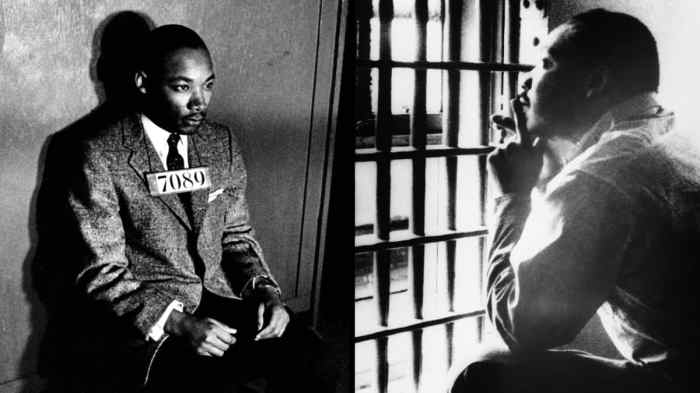From Letter from Birmingham Jail Answers provides a comprehensive examination of Martin Luther King Jr.’s iconic epistle, offering an in-depth analysis of its key themes, rhetorical strategies, and lasting impact on the civil rights movement and beyond.
This work explores the historical context and significance of the letter, dissecting its central arguments against injustice and inequality and its powerful advocacy for nonviolent resistance.
1. Introduction to “Letter from Birmingham Jail”
Martin Luther King Jr.’s “Letter from Birmingham Jail” is a seminal work in the history of the American civil rights movement. Written in 1963 while King was imprisoned for participating in nonviolent protests, the letter is a powerful defense of nonviolent resistance and a scathing indictment of the systemic racism and injustice that pervaded American society.
King’s letter was addressed to eight white clergymen who had criticized his tactics and called for a more moderate approach to the civil rights struggle. In response, King argued that the urgency of the situation demanded more forceful action and that nonviolent resistance was the most effective way to achieve lasting change.
2. Analysis of Key Themes: From Letter From Birmingham Jail Answers
Injustice and Inequality
King’s letter is a powerful indictment of the systemic racism and injustice that pervaded American society in the 1960s. He argues that segregation, discrimination, and violence against African Americans were not isolated incidents but rather the result of a deeply ingrained system of oppression.
Nonviolent Resistance
King was a staunch advocate of nonviolent resistance as a means of achieving social change. He believed that nonviolence was morally superior to violence and that it had the power to transform both the oppressor and the oppressed.
The Role of the Church
King criticized the white church for its silence and complicity in the face of racial injustice. He argued that the church had a moral obligation to speak out against oppression and to work for a more just society.
3. Rhetorical Strategies

Use of Biblical References
King frequently uses biblical references to support his arguments and to appeal to the moral conscience of his readers. He draws on the teachings of Jesus Christ to advocate for love, forgiveness, and nonviolence.
Emotional Appeals
King’s letter is filled with powerful emotional appeals that evoke empathy and compassion for the plight of African Americans. He describes the horrors of segregation and violence in vivid detail and challenges his readers to imagine themselves in the shoes of those who are suffering.
Logical Arguments
In addition to his emotional appeals, King also uses logical arguments to support his case. He points to the historical failures of violence and argues that nonviolent resistance is the only way to achieve lasting change.
4. Impact and Legacy

Influence on the Civil Rights Movement
King’s “Letter from Birmingham Jail” had a profound impact on the civil rights movement. It helped to galvanize support for nonviolent resistance and to inspire a new generation of activists.
Continued Relevance in Contemporary Discussions of Social Justice
King’s letter continues to be relevant today as a powerful reminder of the struggle for social justice. It is a timeless work that speaks to the human capacity for both good and evil and the power of nonviolent resistance to overcome oppression.
5. Literary Analysis
Structure and Organization
King’s letter is carefully structured and organized. It begins with a powerful introduction that sets the stage for his arguments. He then develops his main points in a logical and persuasive manner, using a variety of rhetorical strategies.
Use of Language and Imagery, From letter from birmingham jail answers
King’s letter is written in a clear and concise style that is accessible to a wide audience. He uses vivid language and imagery to create a powerful and moving account of the struggle for civil rights.
Tone and Style
The tone of King’s letter is passionate and urgent, but it is also measured and respectful. He writes with a sense of moral authority and a deep belief in the power of nonviolence.
6. Comparison to Other Works
Martin Luther King Jr.’s “I Have a Dream” Speech
King’s “Letter from Birmingham Jail” and his “I Have a Dream” speech are two of the most famous and influential speeches in American history. Both speeches are powerful calls for racial equality and nonviolence, but they differ in their focus and tone.
Malcolm X’s “Message to the Grassroots”
Malcolm X’s “Message to the Grassroots” is another powerful speech that addresses the issue of racial injustice. Unlike King, Malcolm X advocated for self-defense and armed resistance against oppression.
Detailed FAQs
What is the main purpose of the Letter from Birmingham Jail?
The Letter from Birmingham Jail was written to respond to criticism from white religious leaders who opposed King’s nonviolent protests against segregation and racial injustice.
How does King argue for nonviolent resistance in the letter?
King argues that nonviolent resistance is a moral and effective means of achieving social change because it exposes the injustice of the status quo and appeals to the conscience of the oppressor.
What is the significance of the letter’s biblical references?
King’s use of biblical references adds weight and authority to his arguments, demonstrating the deep connection between his faith and his commitment to social justice.